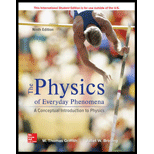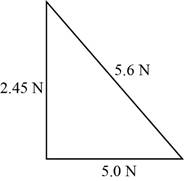
Concept explainers
A 0.25-kg ball is twirled at the end of a string in a horizontal circle with a radius of 0.45 m. The ball travels with a constant speed of 3.0 m/s.
- a. What is the centripetal acceleration of the ball?
- b. What is the magnitude of the horizontal component of the tension in the string required to produce this centripetal acceleration?
- c. What is the magnitude of the vertical component of the tension required to support the weight of the ball?
- d. Draw to scale a vector diagram showing these two components of the tension and estimate the magnitude of the total tension from your diagram. (See appendix C.)
(a)
The centripetal acceleration of the ball.
Answer to Problem 1SP
The centripetal acceleration of the ball is
Explanation of Solution
Given Info: The radius of the circle is
Write the equation for the centripetal acceleration.
Here,
Substitute
Conclusion:
Thus the centripetal acceleration of the ball is
(b)
The magnitude of the horizontal component of the tension in the string required to produce the centripetal acceleration.
Answer to Problem 1SP
The magnitude of the horizontal component of the tension in the string required to produce the centripetal acceleration is
Explanation of Solution
Given Info: The mass of the ball is
The horizontal component of tension in the string provides the centripetal force and the magnitude of horizontal component of tension is equal to the magnitude of the centripetal force.
Write the equation for centripetal force.
Here,
Substitute
Conclusion:
Thus the magnitude of the horizontal component of the tension in the string required to produce the centripetal acceleration is
(c)
The magnitude of the vertical component of the tension required to support the weight of the ball.
Answer to Problem 1SP
The magnitude of the vertical component of the tension required to support the weight of the ball is
Explanation of Solution
Given Info: The mass of the ball is
The vertical component of tension supports the weight of the ball so that vertical component of tension in the string is equal to the weight of the ball.
Write the equation for the weight of the ball.
Here,
The value of
Substitute
Conclusion:
Thus the magnitude of the vertical component of the tension required to support the weight of the ball is
(d)
The vector diagram showing the two components of tension in the string and to estimate the magnitude of the total tension from the diagram.
Answer to Problem 1SP
The vector diagram showing the two components of tension in the string is

Explanation of Solution
If base of a triangle gives the horizontal component of tension and height of the triangle gives the vertical component of tension, then the length of the hypotenuse of the triangle will give the magnitude of the total tension in the string.
The vector diagram is shown in figure 1.

Figure 1
Write the equation for the length of the hypotenuse of the triangle.
Substitute
Conclusion:
The vector diagram showing the two components of tension in the string is plotted in figure 1 and the total tension in the string is
Want to see more full solutions like this?
Chapter 5 Solutions
Physics of Everyday Phenomena
- . A hang glider and its pilot have a total mass equal to 120 kg. While executing a 360° turn, the glider moves in a circle with an 8-m radius. The glider’s speed is 10 m/s. (a) What is the net force on the hang glider? (b) What is the acceleration?arrow_forwardAn athlete swings a ball, connected to the end of a chain, in a horizontal circle. The athlete is able to rotate the ball at the rate of 8.00 rev/s when the length of the chain is 6.600 m. When be increases the length to 0.900 m, he is able to rotate the ball only 6.00 rev/s. (a) Which rate of rotation gives the greater speed for the ball? (b) What is the centripetal acceleration of the ball at 8.00 rev/s? (c) What is the centripetal acceleration at 6.00 rev/s?arrow_forwardA pail of water is rotated in a vertical circle of radius 1.00 m. (a) What two external forces act on the water in the pail? (b) Which of the two forces is most important in causing the water to move in a circle? (c) What is the pails minimum speed at the top of the circle if no water is to spill out? (d) If the pail with the speed found in part (c) were to suddenly disappear at the top of the circle, describe the subsequent motion of the water. Would it differ from the motion of a projectile?arrow_forward
- (a) What is the radius of a bobsled turn banked at 75.0° and taken at 30.0 m/s, assuming it is ideally banked? (b) Calculate the centripetal acceleration. (c) Does this acceleration seem large to you?arrow_forwardObjects moving along a circular path have a centripetal acceleration provided by a net force directed towards the center. Identify the force(s) providing the centripetal acceleration in each of these cases: (a) a planet in circular orbit around its sun; (b) a car going around an unbanked, circular turn; (c) a rock tied to a string and swung in a vertical circle, as it passes through its highest point; and (d) a dry sock in a clothes dryer as it spins in a horizontal circle.arrow_forwardAn ordinary workshop grindstone has a radius of 7.50 cm and rotates at 6500 rev/min. (a) Calculate the magnitude of the centripetal acceleration at its edge in meters per second squared and convert it to multiples of g.arrow_forward
- (a) Calculate the magnitude of the acceleration due to gravity on the surface of Earth due to the Moon. (b) Calculate the magnitude of the acceleration due to gravity at Earth due to the Sun. (c) Take the ratio of the Moon's acceleration to the Sun's and comment on why the tides are predominantly due to the Moon in spite of this number.arrow_forward(a) The Sun orbits the Milky Way galaxy once each 2.60108 y, with a roughly circular orbit averaging 3.00104 light years in radius. (A light year is the distance traveled by light in 1 y.) Calculate the centripetal acceleration of the Sun in its galactic orbit. Does your result support the contention that a nearly inertial frame of reference can be located at the Sun? (b) Calculate the average speed of the Sun in its galactic orbit. Does the answer surprise you?arrow_forwardA pail of water is rotated in a vertical circle of radius 10.00 m. (a) What two external forces act 011 the water in the pail? (b) Which of the two forces is most important in causing the water to move in a circle? (c) What is the pails minimum speed at the top of the circle if no water is to spill out? (d) Assume the pail with the speed found in part (c) were to suddenly disappear at the top of the circle. Describe the subsequent motion of the water. Would it differ from the motion of a projectile?arrow_forward
- Two planets in circular orbits around a star have speed of v and 2v . (a) What is the ratio of the orbital radii of the planets? (b) What is the ratio of their periods?arrow_forwardUsing the average distance of Earth from the Sun, and the orbital peirod of Earth, (a) find the centripetal acceleration of Earth in its motion about the Sun. (b) Compare this value to that of the centripetal acceleration at the equator due to Earth’s rotation.arrow_forwardA woman places her briefcase on the backseat of her car. As she drives to work, the car negotiates an unbanked curve in the road that can be regarded as an arc of a circle of radius 62.0 m. While on the curve, the speed of the car is 15.0 m/s at the instant the briefcase starts to slide across the backseat toward the side of the car. (a) What force causes the centripetal acceleration of the briefcase when it is stationary relative to the car? Under what condition does the briefcase begin to move relative to the car? (b) What is the coefficient of static friction between the briefcase and seat surface?arrow_forward
 College PhysicsPhysicsISBN:9781938168000Author:Paul Peter Urone, Roger HinrichsPublisher:OpenStax College
College PhysicsPhysicsISBN:9781938168000Author:Paul Peter Urone, Roger HinrichsPublisher:OpenStax College College PhysicsPhysicsISBN:9781285737027Author:Raymond A. Serway, Chris VuillePublisher:Cengage Learning
College PhysicsPhysicsISBN:9781285737027Author:Raymond A. Serway, Chris VuillePublisher:Cengage Learning College PhysicsPhysicsISBN:9781305952300Author:Raymond A. Serway, Chris VuillePublisher:Cengage Learning
College PhysicsPhysicsISBN:9781305952300Author:Raymond A. Serway, Chris VuillePublisher:Cengage Learning Physics for Scientists and Engineers, Technology ...PhysicsISBN:9781305116399Author:Raymond A. Serway, John W. JewettPublisher:Cengage Learning
Physics for Scientists and Engineers, Technology ...PhysicsISBN:9781305116399Author:Raymond A. Serway, John W. JewettPublisher:Cengage Learning Principles of Physics: A Calculus-Based TextPhysicsISBN:9781133104261Author:Raymond A. Serway, John W. JewettPublisher:Cengage Learning
Principles of Physics: A Calculus-Based TextPhysicsISBN:9781133104261Author:Raymond A. Serway, John W. JewettPublisher:Cengage Learning University Physics Volume 1PhysicsISBN:9781938168277Author:William Moebs, Samuel J. Ling, Jeff SannyPublisher:OpenStax - Rice University
University Physics Volume 1PhysicsISBN:9781938168277Author:William Moebs, Samuel J. Ling, Jeff SannyPublisher:OpenStax - Rice University





